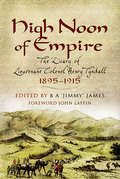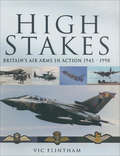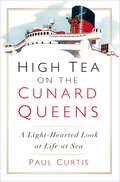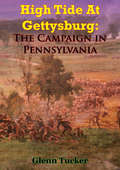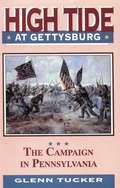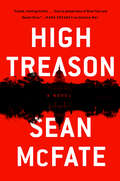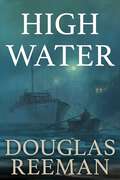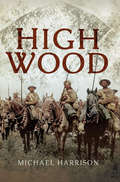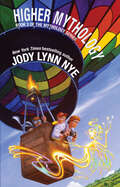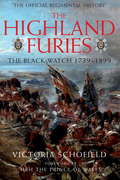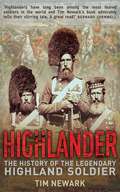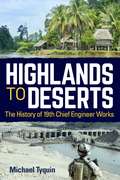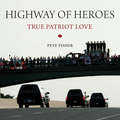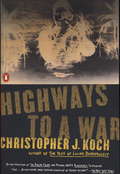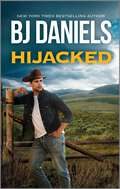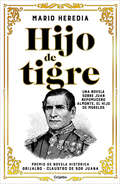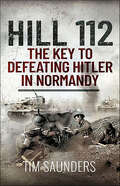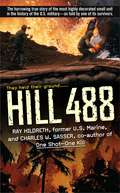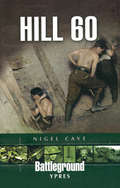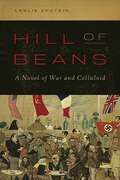- Table View
- List View
High Noon of Empire: The Diary of Lieutenant Colonel Henry Tyndall, 1895–1915
by B A James"Henry Tyndall was a typical product of the Victorian age—an intensely patriotic army officer who served in India, on the North-West Frontier, on the Western Front and in East Africa at the height of the British empire. For 20 years, from 1895 to 1915, he kept a detailed diary that gives a vivid insight into his daily life and concerns, his fellow officers and men, and the British army of his day. He also left a graphic account of his experiences on campaign in the First World War and in the Third Afghan War. B.A. 'Jimmy' James has edited and annotated Tyndall's diary in order to make it fully accessible to the modern reader. As he notes in his introduction, 'this marching soldier of the queen was a gallant officer who conscientiously served his sovereign wherever duty called ... his diary deserves attention as it reflects the manners, customs and attitudes of this vanished age.' "
High Stakes: Britain's Air Arms in Action, 1945–1990
by Vic FlinthamAfter the dust of World War II had settled, the military position of the UK was far from straightforward. It was of course allied to the USA and part of NATO, but it was at odds with the former in maintaining an Empire and the two nations also had competing oil interests in the Middle East. The UK's engagement in war after 1945 was thus a strange mixture ranging from homeland security through insular actions within the colonies or protectorates to preserve empire - to playing a major role in confronting the USSR. The types of active involvement of the RAF, Fleet Air Arm and Army Air Corps between 1945 and 1995 include the following, with examples.Maintaining Local Stability - Greece, Netherlands East Indies. Maintaining Empire - Malaya, Kenya. Defending Empire - Borneo. Defending Interests - Suez, Kuwait. Homeland Security - Northern Ireland, air defence. Confrontation - Berlin Airlift, Korea. Covert Action - Albania, strategic reconnaissance. Humanitarian and Peacekeeping- Jordan, Cyprus. Development of Deterrent - Bombs, bombers and missiles.
High Tea on the Cunard Queens: A Light-Hearted Look at Life at Sea
by Paul CurtisThis amusing insight into Cunard’s legendary liners begins more than fifty years ago when the author joined the original Queen Mary as an entertainments officer, when a part of the job was ‘bumbling’ the passengers while keeping a wary eye out for professional gamblers criss-crossing the Atlantic, and there was bingo and dance bands, novelty dancing and fancy-dress parades, and a primitive disco with a monster juke box. Paul Curtis recounts the stories of the ships, the antics of passengers and crews, and much more besides. Just turning these pages releases a sniff of the sea and a whiff of champagne. This frank and funny account of mixes Cunard history with personal anecdote and vividly reveals how passenger and crew life have changed over the years across the Cunard liners.
High Tide At Gettysburg: The Campaign In Pennsylvania
by Glenn Tucker""Gettysburg had everything," Henry S. Commager recently wrote. "It was the greatest battle ever fought on our continent; it boasts more heroic chapters than any other one battle. It was the high tide of the Confederacy."This is the way Glenn Tucker has always seen it and this is the way he reports it in High Tide at Gettysburg. The story of Gettysburg has never been told better, perhaps never so well as in this volume. Glenn Tucker has the immediacy of a war correspondent on the spot along with the insights that come from painstaking research. The armies live again in his pages.In his big, generous book Glenn Tucker has room to follow Lee's army up from Chancellorsville across Maryland into Pennsylvania. With Jackson recently killed, Lee had revamped his top command.When Meade's men caught up with the Confederates and the two armies were probing to locate each other's concentrations, Mr. Tucker's account becomes sharper, more dramatic. His rapidly moving, vivid narrative of the three-day battle is filled with fascinating episodes and fresh, stimulating appraisals.Glenn Tucker is akin to Ernie Pyle in his interest in people. With him you meet Harry King Burgwyn, "boy colonel" of the 26th North Carolina, just turned twenty-one, who slugged it out with Col. Henry A. Morrow of the 24th Michigan until few survived on either side. You feel the patriotic surge of white-haired William Barksdale, who led his Mississippians on the "grandest charge of the war" and died as he broke the Federal line. You sense the magnetism of Hancock the Superb, and feel the driving power of rugged Uncle John Sedgwick as he hurried his big VI Corps to the battlefield. With Old Man Greene you struggle in the darkness to save the Culp's Hill trenches. And much more. Mr. Tucker weaves in many sharp thumbnail biographical sketches without slowing the action. Many North Carolinians, previously slighted, here receive their due.Full, dramatic, immediate, here is Gettysburg."
High Tide at Gettysburg: The Campaign in Pennsylvania
by Glenn TuckerThe author tries to present how the Gettysburg battle was won and lost, and why the Gettysburg campaign remains such an appealing study to large numbers even after the passing of nearly a century.
High Treason: A Novel (Tom Locke Series #3)
by Sean McFateIn this pulse-pounding action thriller perfect for fans of Brad Thor and David Baldacci, Tom Locke must stop dark forces working to overthrow the president“McFate just might be the next Tom Clancy, only I think he’s even better . . . The action is non-stop and shuttles back and forth between scary-believable and rollicking good fun. I read High Treason during a six-hour plane ride and the trip went by like the snap of my fingers.” —James PattersonWhen the US vice president’s motorcade is hit in a vicious, expertly planned attack, everyone assumes it’s terrorists—everyone except young FBI agent Jennifer Lin. Half a world away, Tom Locke has his own doubts about what happened—and who did it. He suspects his former employer, Apollo Outcomes. But why would the global private military corporation orchestrate such a brutal strike on US soil?Returning to DC, Locke teams with Lin and discovers that a civil war is secretly brewing in the military-contracting world. A division of one company has gone rogue, led by a power-hungry former colleague of Locke’s. But this man couldn’t have pulled it off without help from inside the government.Who could be pulling the strings? Only Locke can get to the bottom of the conspiracy—and blow it apart with one bold strike before it’s too late.“High Treason has brutal assassinations, shocking betrayals, even heated gun battles in the shadow of the White House. It had me breathless—from the sheer audacity of its storytelling to its breakneck pacing. It’s not to be missed!”—James Rollins, #1 New York Times–bestselling author of The Last Odyssey
High Water
by Douglas ReemanWith his own boat, the motor yacht Sea Fox, former naval officer Philip Vivian had hoped to earn a living free from the petty restrictions of everyday life, close to the sea he loved. Now, however, his dream is threatened by financial difficulties. So when a profitable, if legally dubious, proposition is put to him by an old naval comrade in arms, Vivian is willing to listen. But what starts out as a harmless adventure soon turns into something altogether more sinister. Vivian finds himself trapped in a treacherous web of violence and crime, dangerously torn between his stubborn sense of past loyalties and his duty to a society he has always despised.
High Wood
by Michael HarrisonBois de Fourcaux, a luxuriant woodland covering 75 acres, set in the area of the battlefields of the Somme, dominates the surrounding landscape today, as it did in the summer of the year 1916. Known to the British Army as High Wood, the invading Germans had occupied the wood as it proved to be a natural field fortification and a menace that had to be neutralized if the British were to find a way forward in their attempts to breach the trench systems of the German Army and break out into the Green Fields Beyond.This insightful publication will take the battlefield visitor, and also those who are unable to visit the site, on a journey through the history of the battles for High Wood and its environs. It covers the most significant dates in the British Armys struggle to eject the invader and the Germans determination to hold that which they considered to be their new National Frontier. This is the story of the largely amateur British Army of 1916. Lessons were learned in the roaring furnace of the Somme that would transform the fighting ability of the British irrevocably: High Wood was at the epicentre of that learning process.The book contains detailed maps from the time of the High Wood battles using the excellent British Trench maps and, importantly, an explanation on the use of the numbered grid system, which enables the visitor to locate, to within 5 yards, the site of an action that took place 100 years ago. Photographs are also included to enhance the visitor experience. Join us for the journey
High-Speed Marine Craft
by Peter J. MantleThis book details the efforts to build a large naval vessel capable of traveling at one hundred knots. It is the first book to summarize this extensive work from historical and technical perspectives. It explores the unique principles and challenges in the design of high-speed marine craft. This volume explores different hull form concepts, requiring an understanding of the four forces affecting the lift and the drag of the craft. The four forces covered are hydrostatic (buoyancy), hydro-dynamic, aerostatic, and aerodynamic. This text will appeal to naval researchers, architects, graduate students and historians, as well as others generally interested in naval architecture and propulsion.
Higher Mythology (Mythology)
by Jody Lynn NyeHoll, Keith Doyle&’s best friend, has finally tied the knot with his beloved, Maura in the Little Folks&’ new home, Hollow Tree Farm. Keith has good news of his own: he has started on an internship as a copywriter with a Chicago advertising agency, coming up with slogans and designs for new products, but the project he is really enthusiastic over is chasing air sprites in a hot air balloon. Unfortunately, one of the agency&’s client businesses is using the Little Folks&’ land as a dump for toxic waste. Holl&’s young cousin Dola sees them do it, but they see her, too. To prevent anyone else from finding out, then men kidnap her and Holl and Maura&’s new baby, Asrai. All of the Little Folk are called in to hunt for them. Keith reaches out to the new and wonderful air creatures he&’s found in hopes of bringing the baby and her brave guardian back to the farm.
Highest Duty: My Search for What Really Matters
by Jeffrey Zaslow Chesley B. SullenbergerThe inspirational autobiography of the hero pilot who landed a crippled flight in New York’s Hudson River—now a major motion picture starring Tom Hanks.On January 15, 2009, the world witnessed a remarkable emergency landing when Captain “Sully” Sullenberger skillfully glided US Airways Flight 1549 onto the Hudson River, saving the lives of all 155 passengers and crew. His cool actions not only averted tragedy but made him a hero and an inspiration worldwide. His story is now a major motion picture from director/producer Clint Eastwood and stars Tom Hanks, Laura Linney and Aaron Eckhart.Sully’s story is one of dedication, hope, and preparedness, revealing the important lessons he learned through his life, in his military service, and in his work as an airline pilot. It reminds us all that, even in these days of conflict, tragedy and uncertainty, there are values still worth fighting for—that life’s challenges can be met if we’re ready for them.“His fascinating and deservedly praised memoir reflects on his childhood love for planes and an outstanding 42-year career as a pilot—as well as how he and his family coped with the onslaught of sudden celebrity.” —Publishers Weekly
Highland Furies: The Black Watch 1739-1899
by Victoria SchofieldAs the oldest of the Highland Regiments, The Black Watch has an enviable roster of Battle Honours and a mystique born of repeated service on behalf of King, Queen and country. On the strength of her acclaimed biography of Field Marshal Earl Wavell, the regimental trustees commissioned Victoria Schofield to write this, the first volume of her magisterial history of the The Black Watch, and have fully cooperated with her as she traces the story of the Regiment from its early 18th-century beginnings through to the eve of the South African War at the end of the 19th-century. Originating as companies of highland men raised to keep a 'watch' over the Highlands of Scotland, they were formed into a regiment in 1739. Its soldiers would go on to fight with extraordinary bravery and élan in almost every major engagement fought by the British Army during this period, from the American War of Independence, the Peninsular Wars, Waterloo, the Crimea, Indian Mutiny to Egypt and the Sudan. Drawing on diaries, letters and memoirs, Victoria Schofield skilfully weaves the multiple strands of this story into an epic narrative of a valiant body of officers and men over one-and-a-half centuries. In her sure hands, the story of The Black Watch is no arid recitation of campaigns, dates and battle honours, but is instead a rich and compelling record of the soldier's experience under fire and on campaign. It is also a celebration of the deeds of a regiment that has played a unique role in British history and a vivid insight into the lives of the many remarkable figures who have marched and fought so proudly under its Colours.
Highlander: The History of the Legendary Highland Soldier
by Tim NewarkAcclaimed historian Tim Newark tells the story of the Highlanders through the words of the soldiers themselves, from diaries, letters, and journals uncovered from archives in Scotland and around the world. At the Battle of Quebec in 1759, only a few years after their defeat at Culloden, the 78th Highlanders faced down the French guns and turned the battle. At Waterloo, High- landers memorably fought alongside the Scots Greys against Napoleon’s feared Old Guard. In the Crimea, the thin red line stood firm against the charging Russian Hussars and saved the day at Balaclava. Yet this story is also one of betrayal. At Quebec, General Wolfe remarked that, despite the Highlanders’ courage, it was "no great mischief if they fall.” At Dunkirk in May 1940, the 51st Regiment was left to defend the SOE evacuation at St Valery; though following D-Day, the Highlanders were at the forefront of the fighting through France. It is all history, now: Over the last decade the historic regiments have been dismantled, despite widespread protest.Skyhorse Publishing, as well as our Arcade imprint, are proud to publish a broad range of books for readers interested in history--books about World War II, the Third Reich, Hitler and his henchmen, the JFK assassination, conspiracies, the American Civil War, the American Revolution, gladiators, Vikings, ancient Rome, medieval times, the old West, and much more. While not every title we publish becomes a New York Times bestseller or a national bestseller, we are committed to books on subjects that are sometimes overlooked and to authors whose work might not otherwise find a home.
Highlands to Deserts: The History of 19th Chief Engineer Works
by Dr. Michael TyquinHighlands to Deserts is the story of a small Australian Army engineering unit determined to use more than bricks and bridges to make a difference, not only to Australian Army units but to indigenous communities both within Australia and overseas. The 19th Chief Engineer Works was raised in 1963 as the Army&’s premier engineering consultant, its purpose to plan, design and oversee the construction of barracks and training facilities in the New Guinea highlands. However the men of the unit demonstrated vision far beyond their limited brief, reaching into local communities and building relationships with tribesmen that were to prove strong and enduring. From the wilds of New Guinea, the unit extended its reach to the remote communities of outback Australia, designing infrastructure that reflected local needs. The engineers engaged with indigenous townships, cementing relationships as they planned essential infrastructure, their sole aim to make a difference to local lives. The unit&’s military remit ranged from designing bridges and wharfs to training facilities and even churches. The story of the 19th Chief Engineer Works, its people and its achievements, deserves to be far better known and Highlands to Deserts provides rich portrayals of the characters and the trials and tribulations that signpost their history. These are men and women who have invested in communities, large and small, near and far, seeking to improve the daily lives of soldiers and indigenous peoples. Having worked quietly in the background for 55 years, it is now time to tell the story of the 19th Chief Engineer Works.
Highway of Heroes: True Patriot Love
by Pete Fisher General W.J. NatynczykCanadians line the overpasses of the Highway of Heroes to show their support, grief, and pride in our fallen champions. The first four Canadian soldiers killed in Afghanistan were repatriated at Canadas largest military base in 2002. The fallen soldiers were driven down the 172-kilometre stretch of highway between Trenton and Toronto, and pedestrians lined the overpasses, hoping to make a connection with the grieving families. The support these people show isnt political; its not a movement for or against Canadian soldiers in Afghanistan. Its always been a grassroots movement about showing respect for our fallen champions. People young and old, emergency services workers, Canadian Legion members, military personnel, friends of the fallen, and family of fallen soldiers stand atop each bridge along the highway in the blistering heat or bone-chilling cold. After five years of this display of patriotism, the Highway of Heroes was officially named in the summer of 2007 and has been a gleaming example of a nation’s grief and its pride.
Highways to a War
by Christopher J. KochIn a riveting new novel of wartime Cambodia and Vietnam--part thriller, part mystery, part heroic epic--the author of The Year of Living Dangerously offers the story of a likeable, brave, but ultimately mysterious war photographer who has disappeared into the jungles of Cambodia.
Highways to a War
by Christopher J. KochIn a riveting new novel of wartime Cambodia and Vietnam--part thriller, part mystery, part heroic epic--the author of The Year of Living Dangerously offers the story of a likeable, brave, but ultimately mysterious war photographer who has disappeared into the jungles of Cambodia.
Hijacked: A Cowboy Suspense Romance
by B.J. DanielsFrom New York Times and USA Today bestselling author B.J. Daniels. Previously published as Hijacked Bride.He must protect herFrom a man willing to kill to get what he wantsJack Donnovan is out for justice when the woman he loves is targeted in a murder plot by someone from his past. Jack&’s ex business partner has forced Angie Grant to marry him to kill her, claim her inheritance, and exact his own revenge on Jack. It doesn&’t matter that Angie swindled him and broke his heart in the past, Jack is determined to prove that her husband murdered her. Or so he thought…Until he starts seeing Angie&’s face around town again. It seems Angie has secrets of her own. Now Jack must work with an unexpected ally to save his business, his reputation, and the woman he loves from a betrayer hell-bent on revenge.
Hijo de tigre: Una novela sobre Juan Nepomuceno Almonte, el hijo de Morelos
by Mario HerediaEn Hijo de tigre descubrimos a un Juan Nepomuceno Almonte que, con mirada nostálgica, hace balance sobre su vida: sobre lo que cree de sí mismo, lo que creen los demás y los hechos verdaderos. El resultado es un vívido, humano y entrañable retrato en el que el personaje se despoja y trasciende las etiquetas de patriota o traidor. París, 1867. Juan Nepomuceno Almonte, hijo de José María Morelos y Pavón, llega a Francia para solicitar la ayuda de Napoleón III con el fin de sostener el imperio de Maximiliano, sin embargo, no tiene éxito. Unos meses después de la ejecución del emperador, un grupo clandestino de mexicanos y franceses que busca instaurar el Tercer Imperio Mexicano, lo contacta para que apoye sus ambiciones. El enlace entre ellos es un joven y afamado escritor, a quien Almonte narra los grandes acontecimientos de su pasado: el significado de ser hijo del Siervo de la Nación, su participación en algunas batallas por la Independencia cuando era apenas un niño, su posterior estancia en Nueva Orleans, los hitos de su carrera militar y política; así como su relación con Santa Anna, Juárez, Maximiliano, Carlota…
Hijos del miedo
by Trevor ShaneRegla número 1: Prohibido matar a transeúntes inocentes. Regla número 2: Prohibido matar a nadie menor de dieciocho años. Regla número 3: Prohibido tener hijos hasta cumplir dieciocho años. Rompe las reglas y te convertirás en objetivo. En un mundo terriblemente parecido al nuestro, dos bandos se enfrentan en una guerra secreta. Joe participa en ella como un soldado perfecto cuya misión es ejecutar los objetivos que le indican sus superiores, sin cuestionarse unas reglas que no acaba de comprender. De niño le explicaron que el mundo estaba dividido en dos bandos bien diferenciados: el bueno y el malo, pero cuando conoce a Maria esa frontera comienza a desdibujarse. Sus firmes y sangrientas convicciones se desvanecen al tiempo que se impone una la únicay terrible y única verdad: solo hay una cosa más peligrosa que luchar en una guerra: abandonarla. Reseña: «El trabajo de Shane es impresionante. Sabe, sin lugar a dudas, cómo encadenar escenas de acción y crea una tensión casi insoportable. Si lo que buscas es una lectura apasionante y vertiginosa Hijos del miedo es tu mejor opción.»The Saturday Evening Post
Hill 112: The Key to defeating Hitler in Normandy
by Tim Saunders‘He who holds Hill 112 holds Normandy’ seemed an unlikely maxim when the hill is viewed from a distance, but on reaching its plateau, the vistas unfold in every direction across a huge swath of Normandy. For the Germans it was their vital defensive ground, but for the British it was an essential steppingstone en route to the River Orne and access to the open country south to Falaise. The Hitlerjugend SS Panzer Division lost Hill 112 to 4th armored Brigade when the Scots captured the Tourmauville Bridge intact, but the essence of Hill 112’s tactical problem soon became clear. It was impossible for armor to survive on its broad plateau, while the infantry could only hold the skeletal orchards and woods at the cost of crushing casualties. With II SS Panzer Corps preparing to attack the British, the toe hold was given up and 11th armored Division was left holding a bridgehead across the River Odon. Ten days later, 43rd Wessex Division was ordered to resume the advance to the Orne with Hill 112 its first objective. As the west countrymen and tanks rose to advance, they met withering fire from the stronghold that Hill 112 had become. The scene was set for one of the grimmest battles of the campaign. For six weeks from the end of June into August, when the Allied advances finally gained momentum, Hill 112 was far too important to let the opposition hold and exploit it. Consequently, it was regularly shelled and mortared, and shrouded with smoke and dust, while soldiers of both sides clung to their respective rims of the plateau. By the end, Hill 112 had developed a reputation as evil as that of any spot on the First World War’s Western Front.
Hill 488
by Charles W. Sasser Ray HildrethFor some, Hill 488 was just another landmark in the jungles of Vietnam. For the eighteen men of Charlie Company, it was a last stand—this is the stirring combat memoir written by Ray Hildreth, one of the unit's survivors.On June 13, 1966, men of the 1st Recon Battalion, 1st Marine Division were stationed on Hill 488. Before the week was over, they would fight the battle that would make them the most highly decorated small unit in the entire history of the U.S. military, winning a Congressional Medal of Honor, four Navy Crosses, thirteen Silver Stars, and eighteen Purple Hearts—some of them posthumously. During the early evening of June 15, a battalion of hardened North Vietnamese regulars and Viet Cong—outnumbering the Americans 25-to-1—threw everything they had at the sixteen Marines and two Navy corpsmen for the rest of that terror-filled night. Every man who held the hill was either killed or wounded defending the ground with unbelievable courage and unflagging determination—even as reinforcements were on the way. All they had to do was make it until dawn...
Hill 60: Ypres (Battleground Ypres)
by Nigel CaveThe shell-ravaged landscape of Hill 60, some three miles to the south east of Ypres, conceals beneath it a labyrinth of tunnels and underground workings. This small area saw horrendous fighting in the early years of the war as the British and Germans struggled to control its dominant view over Ypres.
Hill of Beans: A Novel of War and Celluloid
by Leslie EpsteinThe film Casablanca opens with the words, &“With the coming of the Second World War, many eyes in imprisoned Europe turned hopefully, or desperately, toward the freedom of the Americas.&” Leslie Epstein&’s Hill of Beans is the story of how one nation, one industry, and in particular one man responded to that desperate hope. That man is Jack Warner. His impossible goal is to make world events—most importantly, the invasion of North Africa by British and American forces in 1942—coincide with the release of his new film about a group of refugees marooned in Morocco. Arrayed against him are Stalin and Hitler, as well as Josef Goebbels, Franklin Roosevelt, a powerful gossip columnist, and above all a beautiful young woman with a terrible secret. His only weapons are his hutzpah and his heroism as he struggles to bring cinema and city, conflict and conference together in an epic command performance.Hill of Beans is the novel that Leslie Epstein—the son and nephew of Philip and Julius Epstein, the screenwriters of Casablanca—was born to write.
Hilldiggers (A Novel of Polity)
by Neal AsherDuring a war between two planets in the same solar system – each occupied by adapted humans – what is thought to be a cosmic superstring is discovered. After being cut, this object collapses into four cylindrical pieces, each about the size of a tube train. Each is densely packed with either alien technology or some kind of life. They are placed for safety in three ozark cylinders of a massively secure space station. There a female research scientist subsequently falls pregnant, and gives birth to quads. Then she commits suicide – but why? By the end of the war one of the contesting planets has been devastated by the hilldiggers – giant space dreadnoughts employing weapons capable of creating mountain ranges. The quads have meanwhile grown up and are assuming positions of power in the post-war society. One of them will eventually gain control of the awesome hilldiggers . . .
